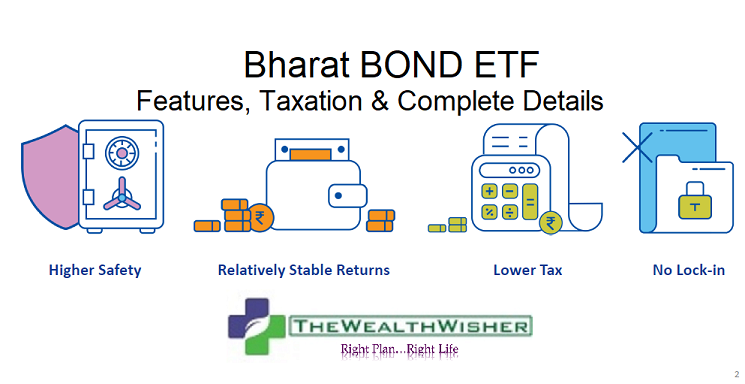The launch of Bharat Bond ETF is now considered as Best Thing Happening Around (BTHA). So, is it so good to miss, or should one invest? Let’s check Bharat Bond ETF – Complete Details, Taxation, Portfolio & Feature of Bharat Bond ETF NFO.
Bharat Bond ETF NFO
The ETF “surname” of Bharat Bond means Exchange Traded Fund. So Bharat Bond ETF will be a Mutual Fund Scheme, managed by Edelweiss Mutual Fund. Once the New Fund Route is over, you can buy & sell the units using your demat & trading account.
So here are the features of Bharat Bond ETF

- Bharat Bond is a pure Debt Fund. Its equity counterpart is Bharat 22 Fund.
- Bharat Bond ETF is proposed to start on 12 Dec 2019.
- It will have 2 schemes – a 3 Year ending in April 2023 & a 10 year variant with maturity in April 2030.
- Bharat Bond ETF is an Index Fund so both options will mimic the exact portfolio created by National Stock Exchange. Here is the 10 year & the 3 Year portfolio.
- There is no entry load to invest. Also, there is no exit load or lock-in period.
- Both variants are simple in working. Means, the valuation of bonds will be determined on a weighted basis and shall be visible through NAV.
- The ETF bonds will return the principal & accumulated growth on maturity. Will not distribute dividends in between.
- Although the NFO is slated this month, the bonds or units will be available for buying & selling post this period via exchange & MF route.
- When you buy or sell via exchange the price will be as per the exchange market price. NAV & Price can be different.
- The expense ratio will be 0.0005%. Lowest ever! Seen in India.
- Very Transparent. As one can see NAV & price on a daily basis. One can also check portfolio.
- It is diversified like a mutual fund scheme as 3 years will have a 15 & 10-year plan has 11 securities to start with.
Is Bharat Bond ETF Risky?
Bharat Bond ETF is a pure Debt product with all companies backed by the government.
These companies have AAA rating, hence the investment is low risk.
Bharat Bond Taxation
Since it is a Mutual Fund, the taxation of Debt Fund will apply.
So if you sell units before 3 years, you will pay Short Term Capital Gain Tax on the gains. This is currently as per your tax bracket. Simple, the gains will add to your income of the year in which you redeemed or exited the bonds.
If you kept & sold after 3rd year, Long Term Capital Gain Tax will apply. This means you will not only get Indexation benefit, but the tax rate will be lower which 20% with indexation benefit.
Since bonds mature in April, the investor gets one more indexation. For a 3-year bond, one gets 4 indexations & for 10 one can get 11 indexation benefits. Look at the illustration below.
Should you invest?
If you have the time horizon of 3 years or 10 years and looking to invest in Debt, the fund can be one of the options.
The fund also scales better on taxation when compared to FDs. It is also better on the Liquidity front in comparison to PPF & EPF (or VPF).
We consider it as an addition to Debt Asset Class & as per the asset allocation, one can channel investments in these bonds.
Bharat Bond Comparison

What does not work is the length of the product. So retirement funds & long term debt investments should not be a part of Bharat Bond ETF unless the goal is in 1 to 10 years.
Random investments – done on the tidal wave of sentiments harm portfolio more than the gains!
How can you invest in Bharat Bond ETF
During NFO (New Fund Offer) & Ongoing BOTH
Option One
Investors holding Demat account can invest in the respective BHARAT Bond ETF through their stockbrokers or online.
Option Two
Through Fund of Fund (FOF) Route. BHARAT Bond FOFs will invest in the respective BHARAT Bond ETF. The minimum investment is Rs 1000.
Returns expected in Bharat Bond ETF
First of all the scheme clearly says it is not capital protection or a fixed return investment.
But, since the bonds have fixed maturity & rates, one can predict the returns. Post-tax returns as mentioned below can be better than prevailing FD rates.
# this is index yield. The investment also gains from appreciation in the prices of the bonds.
Do let us know your queries on this topic in the comments section below.
Some more Articles of Interest:










